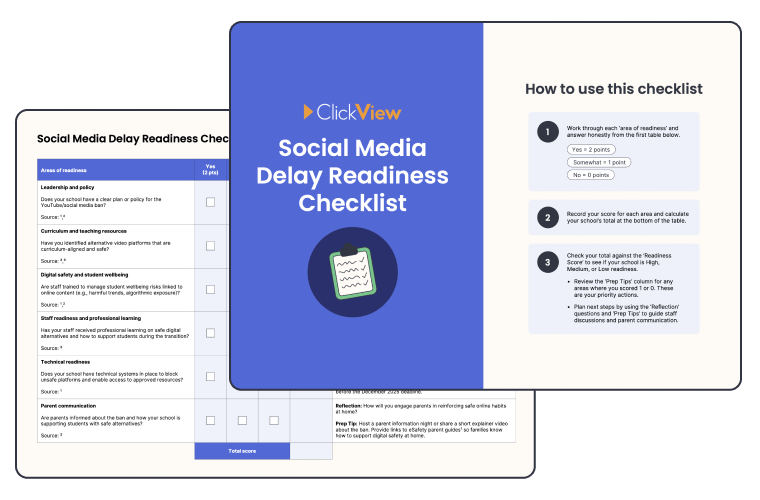What Australian school leaders need to know about the social media ban
Australia’s making a major move in online safety. From 10 December 2025, the Social Media Minimum Age legislation will prevent anyone under 16 from creating or maintaining accounts on platforms like YouTube, TikTok, Instagram, Snapchat, Facebook, and X (eSafety Commissioner, 2025¹).
This change, often called a “social media ban”, is not about limiting learning. It gives students a break from addictive algorithms, unsafe content, and the constant pull of online engagement that can affect focus and wellbeing (eSafety Commissioner, 2025¹; Einstein, 2025²).
At ClickView, we’ve been talking with school leaders about what this means in practice, and the number one question we’re hearing from school leaders is simple: “What do we need to do to stay compliant?”
For more insights, download our Social Media Delay Guide, which provides a detailed overview of survey results, eSafety advice, and safer video alternatives.
Here’s a simple five-step framework you can use to get your school ready.
At a glance: What’s changing
| Key change | What it means for schools |
| Starts: 10 December 2025 | Students under 16 (generally up to Years 10 or 11) lose logged-in access to major social media platforms. |
| Applies to: YouTube, TikTok, Instagram, Snapchat, Facebook, X | Students can still watch videos. Just not while logged in. |
| Goal: Student wellbeing and safer digital environments | Schools must ensure staff and students comply with the new age restrictions. |
1. Be clear about what’s actually changing
Under the new law, students under 16 can’t log in to social media accounts, including YouTube. Teachers can still show videos in class, as long as students don’t need to log in, like, comment, or subscribe (eSafety Commissioner, 2025¹). But the “logged-out” experience isn’t always safer, since ads, autoplay, and recommendations can still expose students to distracting or harmful content (The Guardian, 2025⁴).
Teachers can still use YouTube for lessons, but under-16s will need to be logged out. Embedding videos and using filtering tools becomes part of the new toolkit.
– Sarah Darcy, Assistant Director of Online Safety Education at ACT Education (ClickView Webinar, 2025²)
What to do now:
- Review where YouTube is used in lessons.
- Check that students won’t need to log in.
- Start exploring curriculum-aligned, ad-free alternatives.
2. Audit your readiness now
According to a recent survey of over 430 Australian educators, many schools are feeling unprepared:
| Findings | Percentage |
| Over two-thirds of educators are looking for clearer guidance | 66% |
| An overwhelming majority want their school to provide curriculum-aligned video alternatives | 72% |
| Almost two-thirds say they need significant support to prepare for the changes | 64% |
| Only a small number feel their school is fully prepared | 6% |
If your school doesn’t have a plan yet, use the Social Media Delay Readiness Checklist to assess your readiness across:
- Leadership and policy
- Staff training and confidence
- IT and filtering systems
- Parent communication
Want a copy? Head over to this page or reach out to our team here.

Common quick wins for schools:
- Write a short policy explaining the ban.
- Nominate a compliance lead (e.g., Deputy Principal or eLearning coordinator).
- Audit lessons that rely on YouTube and find replacements.
- Share this teacher blog to help staff prepare for the changes.
3. Support your teachers
Your teachers already manage a lot, so practical support makes all the difference. A recent survey of Australian educators found that many are looking for clearer guidance and reliable classroom tools to help them adapt (ClickView Educator Survey, 2025³):
- 72% want curriculum-aligned, safe video options.
- 66% want clearer guidance on the restrictions
Students skip to main points, attention spans drop, and addictive design undermines learning. The ban is a chance to reset those habits.
– Dr Danielle Einstein, Clinical Psychologist (ClickView Webinar, 2025²)
Practical PD ideas:
- Run a 30-minute PD on “Teaching without YouTube.”
- Show how to embed ClickView or LMS videos.
- Highlight safe, ad-free video alternatives.
- Encourage staff to share replacement resources.
Hot tip! If teachers rely on YouTube videos, they can submit requests on ClickView to have those videos added safely and ad-free for classroom use.
4. Keep parents in the loop
This change affects families as much as schools. Schools that communicate early and clearly have the smoothest transitions (ClickView Webinar, 2025²).
Ways to involve parents:
- Host a short parent information session.
- Include updates in newsletters or assemblies.
- Share why the ban is happening (it’s about protection, not punishment).
Parents can help by:
- Setting healthy device boundaries
- Having regular chats about online habits
- Exploring safe educational platforms at home (eSafety Commissioner, 2025¹)
5. Think beyond “compliance”
As Sarah Darcy, Assistant Director of Online Safety Education at ACT, put it best in the ClickView Webinar (2025²):
Go beyond compliance and aim for best practice in digital citizenship. This is an opportunity to reflect and take positive steps forward.
This shift isn’t just about new rules, but a chance to build a safer, more balanced digital culture in your school.
With ClickView, schools can:
- Keep lessons engaging with curriculum-aligned, ad-free video content.
- Reduce workload with ready-made, classroom-safe resources.
- Stay compliant and confident heading into December.
Ready to prepare your school? Reach out to our friendly ClickView team to see how we can help you.
Sources:
¹ eSafety Commissioner. (2025). Social Media Minimum Age FAQs. Accessed August 2025 from https://www.esafety.gov.au/about-us/industry-regulation/social-media-age-restrictions/faqs
² ClickView. (2025, 27 August). Webinar: Navigating the Social Media Ban Crossroads (Transcript and Slides).
³ ClickView. (2025, 28 August). Educator Survey: Understanding the Impact of YouTube Restrictions in Classrooms (433 submissions, Australia).
⁴ The Guardian. (2025, 22 September). Under-16s may still see gambling, violent, far-right content under Australia’s social media ban, simply by not logging in. Accessed from https://www.theguardian.com/media/2025/sep/22/under-16s-may-still-see-gambling-violent-far-right-content-under-australia-social-media-ban-simply-by-not-logging-in-zero-neo-nazis

Tara Walsh
briefcase iconContent Curation Manager
A qualified teacher and human resources professional, Tara has had an extensive career as a teacher and leader in K-12, and in learning and development.
Other posts
Want more content like this?
Subscribe for blog updates, monthly video releases, trending topics, and exclusive content delivered straight to your inbox.






